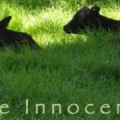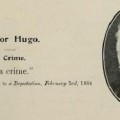 “Christmas is not a time nor a season, but a state of mind. To cherish peace and goodwill, to be plenteous in mercy, is to have the real spirit of Christmas.”
“Christmas is not a time nor a season, but a state of mind. To cherish peace and goodwill, to be plenteous in mercy, is to have the real spirit of Christmas.”
– Calvin Coolidge
The night of the slaughter is neither holy nor silent. In the United States, 22 million turkeys die at Christmas alone. Their deaths are not plenteous in mercy, peace, or goodwill. These animals writhe at the hands of a butcher, and as a result, their necks are secured in a funnel-like device while holding the bird’s reluctant head, the butcher drags a knife down his or her throat. Seasonal in colour, blood embellishes the feathers which were once employed in flight. Whether it be by the rafter or the hundreds, this traditional massacre is being practiced universally.
Most of the turkeys that consumers purchase were raised on a factory farm; though it would come as a surprise. The labels on store-bought turkeys generally depict rolling acres of agricultural paradise or cartoon turkeys enthusiastically sporting a toque blanche. These distortions suggest that a happy, peaceful life was had by the turkey. The labels also inform the consumer that this turkey was Fresh and Young. For some reason, these characteristics are appealing to the consumer, perhaps they are associated with positivity. In actuality, fresh represents their recent slaughter and young signifies a life cut short. These labels pacify consumers, they coerce and sustain ignorance.
It’s fascinating how individuals can remain detached whilst they remove a bag of organs, and possibly even the neck, from the turkey’s dead body. It’s both mesmerizing and infuriating how some of these same people personify the turkey’s dead body: “Put him into the freezer, how is he coming along?”
Responsible for this general disconnectedness could be either the misleading labels or it could be a result of tradition’s powerful reign. Perhaps even some twisted combination thereof. Much like an angel or star on the top of a Christmas tree, no questions are asked in regards to the turkey. Evidently, both are in general acceptance and are of mutual importance.
Due to the factory farm’s stifling conditions, the turkeys are unfathomably distressed. To prevent the birds from killing one another, the tips of their beaks, toes, and the male’s snoods (the flap of skin under their chin) is cut off. No anaesthetic is employed during the entire process. In every aspect of the word, the procedure is excruciating. These extremities of stress even cause some birds to stop eating entirely; they starve to death within the first few weeks of their life.
Much like any factory farmed animal, the turkey is bred to grow at unnatural rates. The larger these animals grow, and in the least amount of time, the more profitable the industry is. The average turkey can way up to 28 pounds. This weight is developed over the span of six to twelve weeks. This is the equivalent to an 18 week old infant weighing approximately 1500 pounds. This weight is so incredibly unnatural and biologically suffocating that these birds are now physically incapable of organic reproduction; all of the turkeys born in the United States on factory farms are now artificially inseminated.
These Fresh Young Turkeys are so overweight that many of them suffer from heart attacks or organ failure before reaching the slaughterhouse. In fact, approximately two million young turkeys will die before even reaching their slaughter-weight. If organ failure and heart attacks do not overcome them, there is a good chance they will be incapable of sustaining their body weight. As a result, they will be unable to stand or walk. Because they cannot reach food or water, these particular birds die from starvation. A torpidly growing turkey may be slaughtered by the factory farm operator so that they do not waste food. A small turkey is an unprofitable turkey. A small turkey is not an impressive centerpiece. These birds are true casualties of Christmas.
More often than not, meandering spirits proudly exclaim how Christmas is about giving to others. This selflessness is nothing more than some distorted self-actualization. Christmas is aching with contradictions; the general theme is peace, mercy, and love while the general feast is fostered by fear, oppression, and carnal lust.




1 Comment
Rooibos (3 comments)
February 2, 2011 at 8:55 am“Christmas is aching with contradictions; the general theme is peace, mercy, and love while the general feast is fostered by fear, oppression, and carnal lust.”
Can we add selfishness, violence, specieism, oppression, slavery…
I don’t celebrate either “thanksgiving” or “christmas” for a variety of reasons.
Regarding the latter, I do not need to be told to be thankful, and when to do it, how to demonstrate it, and which day on the calendar arbitrarily characterizes “thankfulness.”
With both occasions, however, it’s disturbing to me that the supposed demonstration of “thankfulness” is actually the culmination of horrible conditions imposed through animal slavery on other creatures who are held captive and literally tortured while alive, and executed en masse on human whim (selfishness and greed). Then humans proclaim how grateful and thankful and whatever else they are, “celebrating” their violent dominance over the body of an enslaved, incarcerated, abused and vanquished victim, which said humans then proceed to rip apart like morlocks in a butchery pit.
Is this really the extent to which our species has evolved? We can make up interesting tools, but we’re still psychological and morally stunted, bloodthristy, and violent doing to other species what they would never, ever do to us.
If another species came to visit from another planet, would they see our behaviour and attitudes in the same manner – free of human self-interest and human domination? Would they perceive our true nature as a species – how we really are – and because they obviously having nothing to fear of us, would they also be brutally objective and honest about how they perceive our behaviour towards other life forms?
Food for thought.